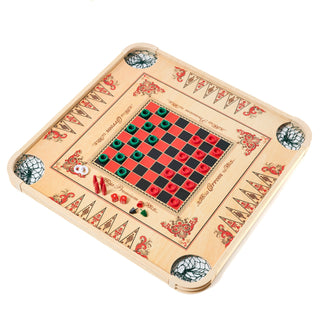This post discusses how to use a 10 team single elimination bracket to hold a tournament. Begin by right-clicking on the image below and selecting “Save Image As” or simply download the PDF version for easy printing. Keep reading to learn how it works.

What is a 10 Team Single Elimination Bracket?
A 10-team single elimination bracket is a scoresheet used to keep track of a mid-sized tournament involving ten teams. In single elimination matches, teams compete in a series of games where the loser of each match is immediately eliminated. The winners of each game progress to the next round, and the tournament continues until a single champion emerges.
Because ten-team eliminations result in an uneven number of teams as the games progress, our approach to this tournament style involves a preliminary round of play between four teams. The second round then moves into a competition between the winners of the first round and the remaining teams. Let’s dive into how it works.
Using the Downloadable Bracket
In our version of a 10-team single elimination bracket, the structure includes four rounds. We use “Games” to mark where you should list competing teams and winners. Record players, winners, and socores as they advance through the rounds:
-
Preliminary Round (Games 1 & 2): Four teams face off to determine which two teams will play in the quarterfinals, evening out the number of participants. Write them all on the bracket. Mark the winner of each match as one of the teams to play in the next round. Note scores if you wish for this round and subsequent rounds.
-
Quarterfinals (Games 2-6): The winner of the first round and the remaining teams are denoted in the brackets for Games 2-6. This will narrow the field down to four teams that will compete in the semifinals.
-
Semifinals (Games 7 & 8): Four teams go head to head to determine who will play in the finals. As with the other rounds, you can use the brackets to denote players, winners, and scores.
-
Finals (Game 9): Write the names of the semifinal winners in the championship match position. Once the final is completed, note the champion prominently on the bracket.
Scheduling Matches
Scheduling for a 10-team single elimination tournament is a matter of accounting for rest time and considering whether you want a fast-paced tournament or to allow all teams to spectate while others are playing:
-
Preliminary Match: Begin the tournament with Games 1 & 2, pairing four teams based on random draw or seeding criteria (see below for more details). This match should take place before the quarterfinals, allowing the winner adequate rest before their next game.
-
Quarterfinals and Beyond: Schedule the remaining matches in a way that ensures enough time for recovery between rounds. You can schedule these games consecutively so that everyone participates at the same time, or you can handle them sequentially, which allows the other teams to spectate. The choice depends on the space you have to play and what you believe will be the most exciting option for your participants. It is often a good idea to hold semi finals consecutively, however, so that eliminated teams can watch.
What Happens in the First Round?
In the first round, four of the teams are paired into a matchup while the rest of the teams sit out the game. These are sometimes called “Preliminary rounds,” but we have chosen to simply label them “Game 1” and “Game 2” on your bracket sheet. Preliminary matches determine which team advances so that there are an even number of players.
What Happens in Subsequent Rounds?
After the first round, the tournament moves into the quarterfinals, semifinals and finals. Quarterfinals involve most of the players and the highest level of engagement from all players. It can often be a good idea to hold these simultaneously if that’s an option. In the semifinals, the winners of the first round compete to determine the two finalists. In the last round, the two teams left standing face off to select the tournament winner.
Selecting the First Round Teams
As we noted above, the first round teams in uneven matches will play a “preliminary” match in order to determine the even number of teams that advance to the main games. There are several approaches to selecting these teams, and you should choose the one that makes the game fairest based on the players you have:
-
Random Selection: Names or numbers representing each team are drawn at random to select the first-round teams. This choice involves the least bias, but may result in teams with mismatched skill levels if your teams are unbalanced.
-
Lowest Seeded Teams: If you’re organizing a tournament based on skill (i.e. “seeding”), then it’s customary to choose the lowest ranked teams to face off in the first round to ensure a better balance in later games.
-
Volunteer or Rotational System: In casual settings, teams can volunteer for the first round, or it can rotate between teams if the tournament format allows for multiple rounds.
Different Ways to Draw
A "draw" refers to the method used to determine how teams or participants are placed into the tournament bracket.
Blind or Random Draw
Blind (aka Random) Draws involve assigning teams to their bracket positions randomly. This method is simple and adds an element of unpredictability to the tournament, but it does not take into account skill level, which can sometimes impact the fairness of the outcome.
Seeded Draw
In a seeded draw, teams are ranked based on skill, age, or past performance, and placements are designed to prevent the strongest teams from meeting in early rounds. Teams are assigned a “seed” (a number that designates their strength), and then paired so that the top two teams are not assigned together. This can be ideal in, for instance, a family setting where adults might have an advantage over younger children.
Randomized but Balanced
Teams are drawn randomly, but adjustments are made to avoid early matchups between the strongest participants. This method balances fairness with excitement.
How to Handle Tiebreakers
Tiebreakers can occur in tightly contested matches, and it’s essential to establish clear rules beforehand. Having a plan in place ensures fairness and helps avoid disputes later on. To resolve a tie, you can try one of the following methods:
-
Extra Time: Adding additional playtime to break the tie.
-
Sudden Death: The tied teams face off, and the first team to score or achieve a point wins.
-
Skill Challenge: Similar to sudden death, this type of tiebreaker involves setting up a specific skill-based competition, such as a penalty shootout or face-off.
Dealing with Eliminations Gracefully
Losing is an inherent part of single elimination tournaments. It’s important to handle eliminations in a way that maintains a sense of good will. Make sure to celebrate participation by appreciating and acknowledging the efforts of eliminated teams. You may also choose to offer consolation matches, which means allowing eliminated teams to play additional matches for placement. Finally, sharing performance highlights can keep morale high and encourage future participation.
Using Single Elimination Bracket for Nok Hockey Tournaments
Single elimination brackets are a great fit for Nok Hockey tournaments, especially within families and friend groups. Tournaments can be the perfect way to encourage longer play that’s both intense and engaging. It also allows you to involve a larger number of people even when you only have a single Nok Hockey table.
Nok Hockey tournaments in the single elimination format are especially good for engaging competition within larger group settings, such as birthdays, family gatherings, and holidays. It allows you to compensate for different skill levels as well, making competitive play possible amongst mixed-age groups.
Learn how to play Nok Hockey, Skittles, or Carrom by clicking one of the links!
All Tournament Brackets for Download
- 4 Team Single Elimination Bracket
- 5 Team Single Elimination Bracket
- 6 Team Single Elimination Bracket
- 7 Team Single Elimination Bracket
- 8 Team Single Elimination Bracket
- 9 Team Single Elimination Bracket
- 11 Team Single Elimination Bracket
- 12 Team Single Elimination Bracket
- 14 Team Single Elimination Bracket
- 15 Team Single Elimination Bracket
- 16 Team Single Elimination Bracket

